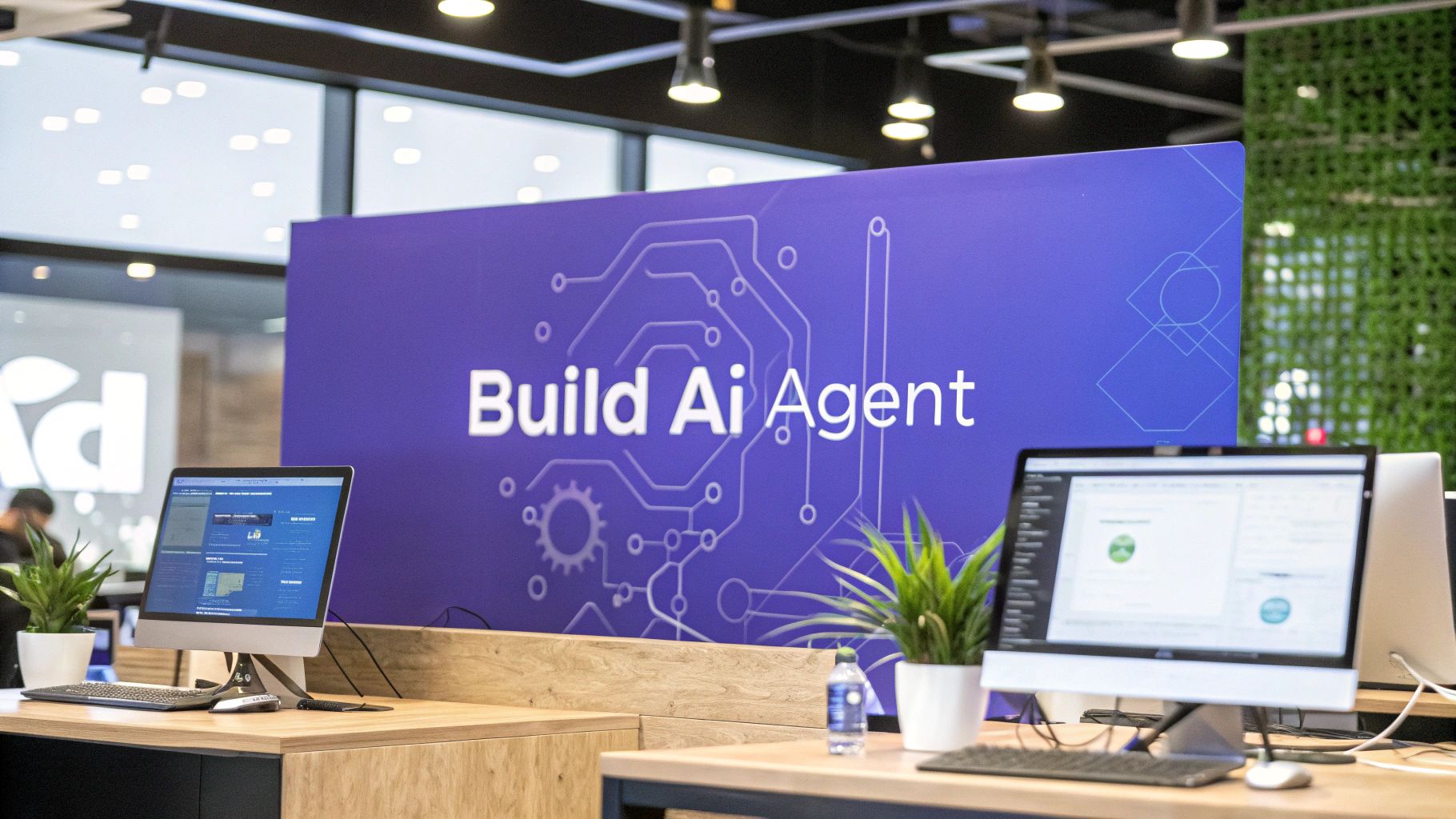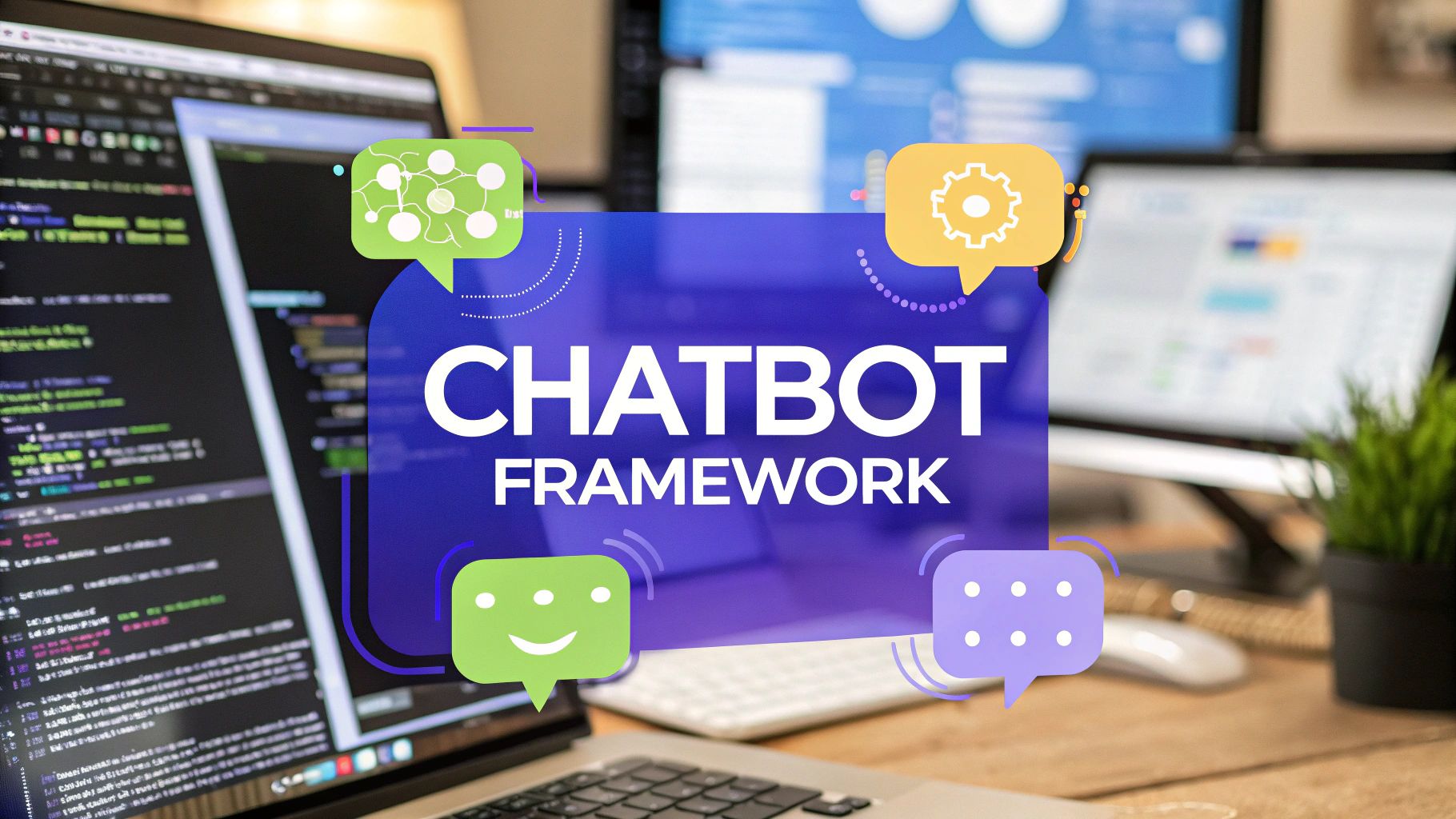Building an AI Agent: Your Complete Step-by-Step Guide
Learn how to build an AI agent with our easy-to-follow guide. Discover key steps from concept to deployment and start building an ai agent today!
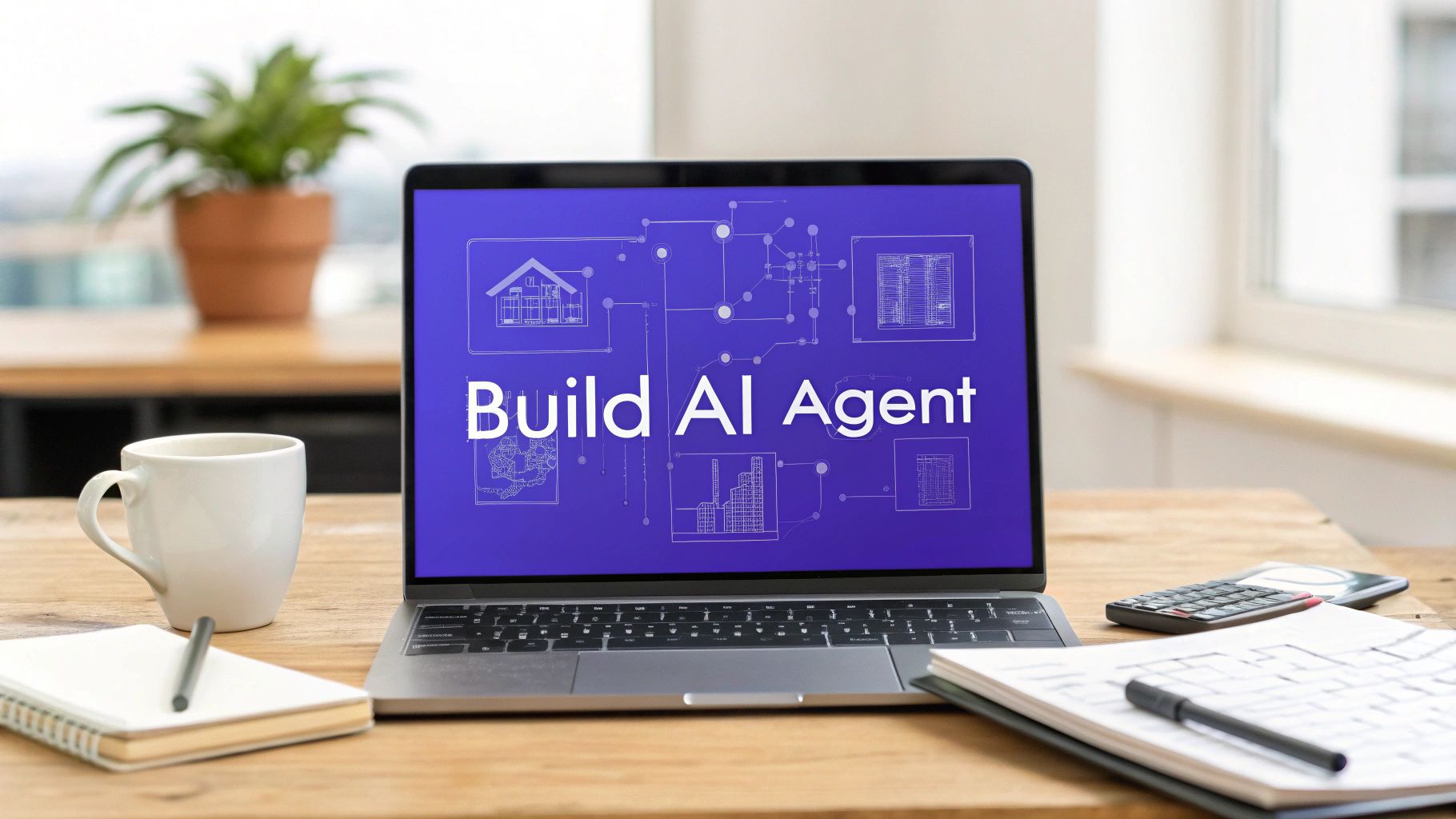
Building an AI agent is more than just coding. It involves creating a system that can observe its surroundings, think through its options, and then act to hit a specific goal. A good agent does more than follow orders; it learns from new information and gets better over time.
What Building an AI Agent Really Means
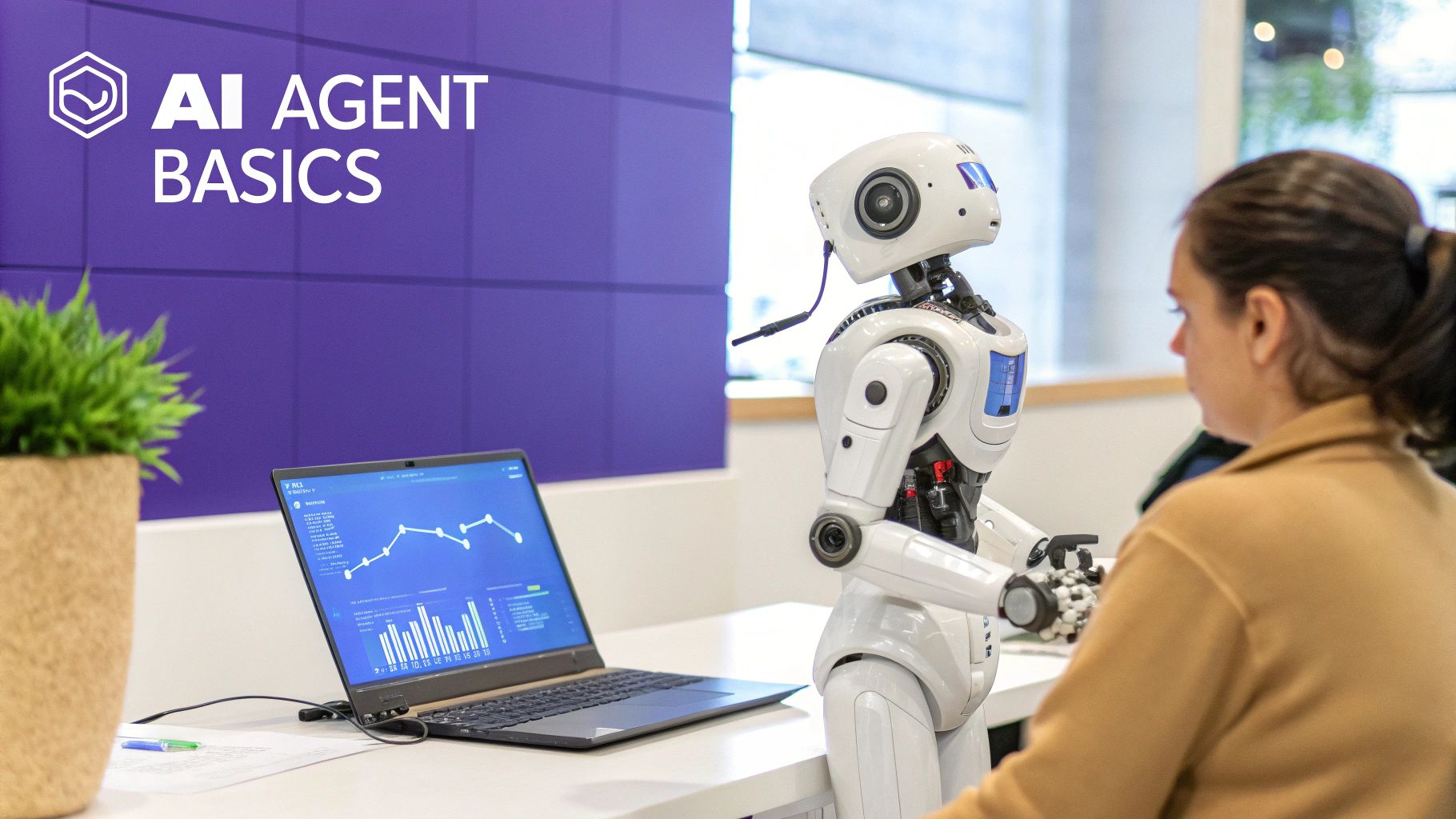
Before you jump into the technical side, it's worth getting a feel for the core concepts. You're not just writing a script; you're designing something that can operate intelligently on its own to tackle real problems.
Think of it like training a new hire. You wouldn't just hand them a rigid checklist. You'd give them a clear objective, the right tools, and show them how to use information to make smart decisions. An AI agent is built on that same foundation.
The idea of intelligent machines isn't new, of course. The groundwork for today's autonomous systems was laid back in the mid-20th century. Back in 1950, Alan Turing came up with the Turing Test to see if a machine could act in a way that was indistinguishable from a human. Just six years later, the Dartmouth Conference officially coined the term 'Artificial Intelligence,' kickstarting the whole field.
The Core Parts of an AI Agent
No matter how complex they get, all AI agents are built from a few fundamental pieces. Knowing what they are will help you map out your own agent's design from the start.
- The Agent: This is the brain of the operation, the part that makes the decisions. It could be a customer service chatbot, a system combing through financial data, or a robot moving around a warehouse.
- The Environment: This is the world the agent lives and works in. For a chatbot, the environment is a chat window. For a stock-trading agent, it’s the fast-paced financial market.
- Sensors: These are the agent's "senses" which are the tools it uses to perceive its environment. A chatbot's sensor is the text a user types, while a self-driving car uses a whole suite of cameras and LiDAR.
- Actuators: These are the agent's "hands" which are what it uses to take action. A chatbot's actuator is its ability to send a reply, while a robotic arm’s actuator is its motor.
This loop of sensing the world, processing what it means, and then taking an action is the heartbeat of every single agent.
To give you a clearer picture, here’s a quick breakdown of how these components fit together.
Key AI Agent Components at a Glance
Thinking in these terms helps you break down a complex problem into manageable parts before you start building.
From Simple Rules to Smart Learning
The first AI systems were pretty rigid. They were almost entirely rule-based, meaning you had to manually program a response for every possible scenario. If a user says "X," the bot must reply with "Y." It works, but it’s brittle and completely falls apart when faced with something unexpected.
Modern AI agents are far more dynamic. Instead of being locked into a fixed set of rules, they often use machine learning models, especially Large Language Models (LLMs), as their "brain." This gives them the power to understand context, reason through problems, and come up with surprisingly human-like responses. To get a better sense of the tools and methods involved here, check out A Practical Guide to AI-Powered Software Development.
A key shift in building an AI agent today is moving from programming explicit logic to guiding an intelligent model. You're not just telling it what to do, but teaching it how to think about a problem.
Agents come in different flavors, too. Simple reflex agents just react to what they see in the moment without any memory of the past. More advanced agents maintain an internal "state," letting them make smarter decisions based on what’s happened before. The most sophisticated are learning agents, which can actually improve their performance by analyzing their own actions and outcomes. You can explore a more detailed breakdown of these types in our guide to AI agents: https://www.chatiant.com/blog/agents-ai. Getting this foundational knowledge right is key to making good decisions when you start building.
Choose Your Tools and Define Your Agent's Goal
Now that you have a solid idea of what an AI agent is, it’s time to get practical. This is where you'll make two of the most important decisions in the entire process: picking your toolkit and pinning down a clear, specific goal for your agent. These choices set the foundation for everything that follows.
What will your agent actually do? Will it be a customer service bot that handles common questions? Or maybe a data analysis assistant that surfaces trends in sales figures? A well-defined objective is your North Star and will guide every single decision from here on out.
This simple flow shows how you move from the technical foundation to the business objective and, finally, to how you'll measure success. A clear goal is the bridge between the tools you pick and the results you see.
Selecting the Right Framework
The framework you choose is the bedrock of your project. Different tools are built for different tasks, complexities, and levels of technical skill.
- TensorFlow & PyTorch: These are heavy-duty, open-source libraries for developers who need fine-grained control. They’re the go-to for building custom machine learning models from scratch and offer massive flexibility for complex projects. Just know they come with a steep learning curve and require serious coding knowledge.
- Chatiant: This platform is designed for a completely different approach. It’s a great fit if you want to build a functional, goal-oriented agent without getting bogged down in code. If your aim is to get a customer service assistant or an internal helpdesk bot up and running quickly, a tool like this is the most direct path. You can learn more about this in our guide to using a no-code AI agent builder.
Your choice here really depends on your project’s scope and your team’s skills. For a highly specialized, novel AI task, TensorFlow might be the right call. For a business-focused agent designed to automate a specific workflow, Chatiant offers a much faster route to the finish line.
Why a Clear Goal Is So Important
Defining your agent’s purpose is more than just a high-level idea; it’s about setting concrete boundaries. A customer service agent, for example, needs to know its limits. Can it process refunds, or is its job just to answer product questions?
Without a narrow scope, you risk building an agent that does many things poorly instead of one thing exceptionally well. A focused goal prevents "scope creep" and makes the training and testing phases far more manageable.
The most successful AI agents are the ones with the most clearly defined jobs. An agent built to "handle customer support" is too broad. An agent built to "answer shipping status questions and escalate complex issues to a human" is specific, measurable, and achievable.
This level of detail helps you zero in on the exact data you'll need for training and the specific metrics that will spell success. It's the difference between a vague concept and a workable project plan.
A Checklist for Defining Your Agent’s Mission
To make this process concrete, just work through this simple checklist. Answering these questions will give you a clear and actionable brief for your project.
- What is the single primary task? Start with one core function. For instance, "Book meetings based on calendar availability." You can always expand its skills later on.
- Who is the end-user? Is this for customers on your website or for your internal sales team? The audience dictates the agent's tone, the information it needs, and where it will live.
- What does success look like? Define your key metrics from the get-go. For a scheduling agent, success might be the percentage of meetings booked without human intervention. For a support bot, it could be the ticket deflection rate.
- What are the boundaries? Clearly list what the agent will not do. For the scheduling agent, a boundary might be that it cannot reschedule meetings on behalf of other people. This prevents user frustration and sets clear expectations.
Taking the time to choose the right tools and meticulously define your agent's goal is the most important prep work you can do. It turns an abstract idea into a concrete plan and sets you up for a much smoother ride.
Design Your Agent's Architecture
Once you’ve locked in a clear goal, it's time to map out how your agent will actually think. This is its architecture, the blueprint dictating how it sees its world, processes information, and makes decisions. You're shifting from defining what the agent does to outlining how it gets it done.
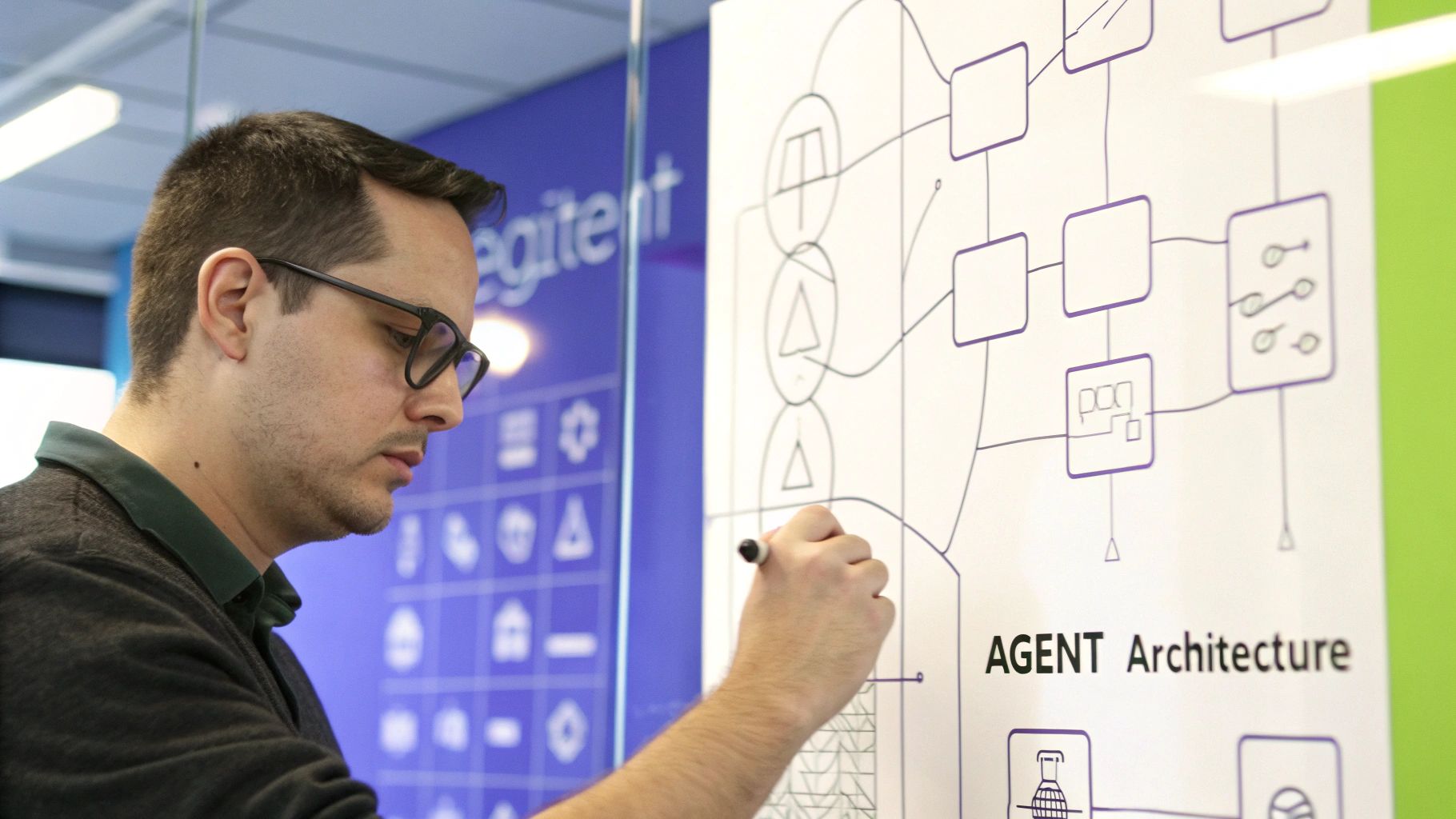
The old way of building agents was painstaking. It involved mapping out complex, rigid logic trees. If a user says this, do that. You had to try and predict every single possible interaction, a process that was both brittle and incredibly limiting.
Thankfully, modern agent design has moved far beyond that, thanks to a huge shift in AI.
The rise of large language models (LLMs) completely changed the game. Older agents relied on handcrafted rules or narrow models trained for just one specific task. But when models like OpenAI's GPT-3 arrived in 2020 with 175 billion parameters, everything changed. Their sheer scale allowed them to handle diverse language tasks like reasoning and dialogue generation with very little specific training.
The LLM as the Agent's Brain
Think of the LLM as the central processing unit or "brain" of your agent. Instead of writing code for every possible decision, you simply give the LLM a goal, some context, and a set of tools it can use. The LLM then uses its built-in reasoning abilities to figure out the best course of action on its own.
This makes the agent incredibly flexible and adaptable. It can handle unexpected user requests, understand nuanced language, and even reason through multi-step problems without you having to pre-program every single possibility.
Your job shifts from being a programmer who dictates every action to being an architect who designs a system for intelligent decision-making. You're setting up the environment, and the LLM navigates it.
This approach is what allows you to build an agent that feels genuinely helpful instead of just robotic. The whole system is built around a continuous workflow that guides the agent’s behavior from one moment to the next.
Structuring the Perception-Action Loop
At the heart of any agent's architecture is the perception-action loop. It’s the fundamental cycle where the agent observes what’s happening, thinks about what to do, and then takes action.
- Perception: The agent gets new information. For a scheduling assistant, this could be an email from a user asking to set up a meeting.
- Processing (Thought): The LLM kicks in to analyze the input. It pulls out key details like who to meet, the topic, and any time constraints. It then decides which tool it needs, like a calendar API.
- Action: The agent executes its chosen action. It might call the calendar API to check for open slots, then formulate an email suggesting a few meeting times.
This loop repeats with every new piece of information, letting the agent have a dynamic, back-and-forth conversation as it moves closer to its goal. When designing your agent, you’re really just defining what happens at each stage of this loop. It's also worth exploring platforms that are unlocking GenAI capabilities with real-time data streaming to make sure your agent has the most current information to act on.
A Scheduling Assistant’s Architecture in Action
Let’s make this more concrete. Imagine you're building an AI agent to handle your meeting scheduling.
Here’s a simplified look at what its architecture would look like:
- Goal: Schedule a meeting with a specific person on a given topic.
- Tools: Access to your calendar API (to check availability) and an email client (to send messages).
- Perception: It receives an email: "Hey, can you set up a 30-minute call with Jane Doe next week to discuss the Q3 report?"
- Processing: The LLM identifies the key entities: "Jane Doe," "30-minute call," "next week," and "Q3 report." It understands the goal is to schedule a meeting and decides the next logical step is to check the calendar.
- Action: The agent calls the calendar API to find available 30-minute slots for next week.
- Perception (New Input): The calendar API comes back with three open slots.
- Processing: The LLM now has the available times. It figures the next step is to propose these times to the original sender.
- Action: The agent drafts and sends an email: "Of course. How about one of these times next week: Tuesday at 10:00 AM, Wednesday at 2:30 PM, or Friday at 11:00 AM?"
Pre-training: This is the heavy lifting done by giants like OpenAI or Google. They train massive models on a huge, diverse dataset scraped from the internet. This gives the model a broad knowledge of language, facts, and reasoning, but it knows nothing specific about your company.
Fine-tuning: This is where you step in. Fine-tuning takes a pre-trained model and continues its training, but with a much smaller, highly specialized dataset from your business. This process nudges the model’s parameters to excel at a very specific task, like answering questions about your product lineup.
- Prompt: "A customer is asking for a refund for order #12345 because it arrived damaged. How should I respond?"
- Completion: "I'm so sorry to hear your order arrived damaged. I've processed a full refund for order #12345, which should appear in your account within 3-5 business days. Please let me know if there's anything else I can help with."
- Use a Diverse Dataset: Make sure your training examples cover a wide range of scenarios, not just the most common ones.
- Keep it Concise: Don't overdo it. Sometimes, training for too long on a small dataset is what leads to memorization.
- Validation Sets: Set aside a chunk of your data just for validation. You don't use this data for training; instead, you use it to test the model's performance on unseen examples. If performance on the validation set starts to drop while training performance keeps improving, you’re likely overfitting.
- Accuracy: Does the agent pull the right information and use its tools correctly? An 85% accuracy rate is a good initial target for many tasks.
- Response Quality: Is the agent's language natural, helpful, and on-brand? How does it handle unexpected questions?
- Safety and Guardrails: Does the agent refuse to answer inappropriate questions? Does it stick to its defined operational boundaries?
- A web application: Embedded as a chat widget on your website for customer support.
- A messaging platform: Integrated into Slack or Google Chat for internal teams.
- A mobile app: Serving as a personal assistant for users on the go.
- Development Time: Are you using a no-code platform like Chatiant, or are you hiring a team of AI developers? The difference in labor costs here is massive.
- Infrastructure: Training and running big models requires some serious horsepower. You'll likely be renting powerful GPUs from cloud providers like AWS or Google Cloud.
- API Calls: If your agent leans on third-party models from places like OpenAI, you'll pay based on usage. The more it's used, the more you pay.
- Data Acquisition: Sometimes you need a very specific dataset. Buying or creating one can be a project in and of itself.
This example shows how the architecture isn't a static flowchart but a dynamic system where the LLM's reasoning guides the agent from one step to the next. Your role is simply to give it the right goal, the right tools, and a clear workflow to follow.
Train and Fine-Tune Your AI Agent
An off-the-shelf model is a fantastic starting point, but a generic AI won’t cut it for long. To create an agent that’s truly effective, you need to train it on data that’s relevant to your business. This is how you turn a generalist into a specialist that gets the unique language, nuances, and workflows of your organization.
Ultimately, the agent’s performance comes down to the quality of the information it learns from.
Think of it this way: you’re giving your agent its own specialized textbook. It could be learning from past support tickets to become a customer service pro or analyzing sales transcripts to spot buying signals. The data you feed it is what teaches it how to do its job.
Pre-Training vs. Fine-Tuning
It helps to get a couple of key concepts straight right away: pre-training and fine-tuning.
You won't be pre-training a model from scratch. You’ll be fine-tuning an existing one, which is massively more efficient and cost-effective.
Creating a High-Quality Dataset
The success of your agent hinges entirely on your dataset. Building an AI that performs well requires clean, relevant, and well-structured data. For a customer support agent, for example, your dataset might consist of hundreds or thousands of prompt-completion pairs.
Here’s a simple example:
This kind of structured data teaches the agent the right tone, what information to include, and which actions to take in specific scenarios. If you want to dig deeper into this, our guide on how to train a chatbot has some great practical steps.
One of the most common mistakes I see is teams feeding their model messy or irrelevant data. Always remember the "garbage in, garbage out" principle. A small, high-quality dataset of 200 excellent examples will get you far better results than a dataset of 2,000 poor ones.
Take the time to clean your data. Remove duplicates, correct errors, and make sure every single example aligns perfectly with how you want the agent to behave. All that upfront work pays off big time when you see the agent’s final performance.
Avoiding the Overfitting Trap
As you fine-tune, there’s one big problem to watch out for: overfitting. This happens when the model basically memorizes the training data instead of learning the underlying patterns. An overfit model will perform flawlessly on examples it’s already seen but will completely fall apart when it encounters new, slightly different situations.
It's like a student who memorizes the answers to a practice test but doesn't actually understand the subject. They're lost when the real test has slightly different questions.
Here are a few ways to steer clear of this:
Refining Behavior with Human Feedback
A really powerful technique for polishing an agent’s behavior is Reinforcement Learning from Human Feedback (RLHF). This method goes way beyond simple prompt-completion pairs.
With RLHF, you give the agent a prompt, and it generates several possible responses. A human reviewer then ranks those responses from best to worst.
This feedback loop teaches the agent all the nuances of helpful, harmless, and accurate communication. It's a huge reason why modern AI models have become so good at following complex instructions and adopting specific personas. The development of AI agents has accelerated dramatically due to advances in deep learning and reinforcement learning. A huge step forward happened in 2015 when Google DeepMind showed how a model could master Atari games just from pixel inputs, proving AI could learn complex tasks without hand-coded instructions. You can explore a detailed history of these breakthroughs on The Ground Truth.
Test and Deploy Your Finished Agent

You’ve done the hard work of training and fine-tuning, and now you have a smart, specialized AI agent. But before you let it loose in the wild to interact with real users, it’s time for some serious testing. This stage is all about making sure your agent isn’t just functional but also reliable, safe, and genuinely helpful.
A rushed deployment can lead to frustrated users and a damaged reputation. Think of testing as the final quality check before opening night. It confirms that all your effort in the training phase paid off and that the agent is truly ready for the real world.
A Practical Strategy for Testing Your Agent
A solid testing plan needs to look at your agent from multiple angles, checking both the small details and the big picture to catch any potential issues.
First up is unit testing. This is where you test each individual skill or component of your agent in isolation. If you built a scheduling assistant, for instance, you’d test its ability to correctly ping the calendar API, its skill in drafting emails, and its logic for parsing dates. This confirms all the basic building blocks are solid.
From there, you move on to end-to-end testing. This is where you simulate a complete user interaction from start to finish. You’d give the agent a real-world task like, "Book a 45-minute call with the marketing team for next Tuesday afternoon," and watch to see if it can complete the entire workflow without any hiccups.
Building a Testing Rubric
To keep your testing objective, you need a clear way to measure performance. This is where a testing rubric comes in. It’s a scorecard that grades your agent against the goals you set from the very beginning.
Your rubric should track a few key areas:
A structured rubric turns testing from a gut-feel exercise into a data-driven process. It gives you concrete numbers to decide if the agent is ready or if it needs more fine-tuning.
You’ll likely go through a few rounds of testing and tweaking. Don't get discouraged if you find problems; that’s exactly what testing is for. Every issue you fix now is one less headache your users will have to deal with later.
Choosing Your Deployment Environment
Once your agent has passed its tests with flying colors, it's time to decide where it’s going to live. The deployment environment you choose will directly impact its scalability, security, and your budget.
Your agent could be deployed in a few common spots:
The right choice depends entirely on where your target users already are. The goal is to make the agent accessible right where people do their work, with as little friction as possible.
Cloud Services vs. On-Premises Servers
The final piece of the deployment puzzle is the infrastructure that will run your agent. You generally have two main options here, each with its own set of trade-offs.
For most projects, starting with a cloud provider like AWS or Google Cloud is the most practical choice. It gives you the flexibility to scale up or down as needed without a massive initial investment. With your agent tested and your deployment plan locked in, you’re finally ready to introduce your creation to the world.
Common Questions About Building AI Agents
As you start exploring how to build an AI agent, a few big questions always pop up. Getting a handle on these early on helps you set realistic expectations, figure out a budget, and pick the right path for your project. Let's break down what people usually ask.
How Much Does It Cost to Build an AI Agent?
This is the classic "it depends" answer, but it's true. The cost can swing from practically zero to a serious investment. The final bill really comes down to how complex the agent is, the tools you use, and the data it needs to learn from.
For a simple agent cobbled together with open-source frameworks and a few APIs, your biggest cost might just be your own time and some minor API fees. It's a great way to get your feet wet.
But if you're building a highly specialized agent for a niche industry, the costs can stack up fast. We're talking about things like:
What Programming Language Is Best for AI Agents?
Python is the undisputed king of AI development, and for good reason. It has a massive ecosystem of libraries built specifically for machine learning and data science. Tools like TensorFlow, PyTorch, and Scikit-learn make it way easier to build, train, and deploy models without reinventing the wheel.
Sure, other languages like C++ or Java have their moments, especially when raw performance is the absolute top priority. But for most AI agent projects, Python's huge community, wealth of pre-built tools, and rapid development speed make it the most practical choice by a long shot.
You could technically build an agent in another language, but you'd be swimming against the current. Sticking with Python gives you access to a wealth of tutorials, community forums, and ready-made code that will make your life much, much easier.
How Long Does It Take to Build an AI Agent?
Just like cost, the timeline is all over the map. The single biggest factor is the scope of your project. What do you actually want this agent to do?
You could probably whip up a simple proof-of-concept in just a few weeks. Think of a basic chatbot that answers a handful of questions using a pre-trained model. It’s the perfect way to test an idea without sinking a ton of resources into it.
On the other hand, a production-ready, highly specialized agent is a whole different beast. If your project involves collecting custom data, spending weeks fine-tuning a model, and running it through rigorous testing to make sure it's reliable and safe, you should be planning for several months or even longer.
The best way to keep the project from spiraling out of control? A crystal-clear, well-defined goal from day one.
Ready to build a powerful AI agent without getting lost in code? With Chatiant, you can create and deploy custom agents trained on your own data in minutes. Automate customer support, streamline internal workflows, and deliver better experiences.
